If you want to know about the acoustics in auditorium or acoustics material analysis or acoustics in landscape, please click the link.
Acoustic insulation refers to the use of materials or techniques to reduce the transmission of sound from one space to another. The effectiveness of acoustic insulation depends on factors such as the type and thickness of the materials used, the structure of the building, and the specific sound frequencies being targeted.
1) Introduction
i) Sound insulation
Soundproofing is one of the very basic problems in acoustic construction. Reducing the transmission of sound from one area to another usually through a solid barrier, is a common requirement.
- Sound transmission works both ways:
- sometimes sound needs to be prevented from escaping a room, sometimes from entering it.

ii) Basic methods of acoustic separation
- A few basic strategies can be used to achieve the desired sonic separation:
iii) Locate critical areas away from each other
- While often not feasible due to external factors, such as the available space, choosing optimum adjacencies can significantly reduce the need for sound insulating construction.
- Distance is a major factor in reducing sound energy, particularly for airborne sound. Attention must be paid to all three spatial directions, e.g., Horizontal separation in a building can be rendered meaningless by a close vertical adjacency
2) Factors affecting sound Insulation
i) Flanking paths
- Sound, like water, will find the path of least resistance.
- Flanking paths around sound insulating elements can severely compromise the whole system. Secondary sound paths can easily be over-looked, but should be avoided.
ii) Leakage
- Small breaks in an assembly reduce the effect of sound insulation measures significantly.
- A hole only one ten-thousandths of the total enclosure area can decrease the overall sound transmission value to half or less.
- The higher the basic insulation value is without an air leak, the greater the detrimental effect of any break.

iii) Weak links
- The weakest link in any construction assembly will have the greatest impact on the overall level of sound insulation.
- A solid wall is only as soundproof, where as, a door or a window can’t absorb the sound.
3) Acoustic insulation methods
i) Insulation methods
- Successful ways to increase the transmission loss values of a structure include the use of heavy mass, composite construction systems, structural separations, separation with airspace.
- Most effective are combinations of any of the categories.
ii) Insulation with mass
- Heavyweight construction generally achieves better sound insulation values than lightweight construction.
- The insulation value of a barrier is also related to the frequency or wavelength of the sound.
- Higher frequencies require more force to vibrate a barrier – lower frequencies are transmitted with less force.
- A heavy barrier requires more force to vibrate – a lightweight panel vibrates more easily.
- Barriers with little mass offer limited transmission loss values; even less for lower frequencies than for higher frequencies.
- Barriers with heavy mass result in high transmission loss values, especially for high frequencies.
4) Mass law theory
i) Mass law theory
- For homogenous building materials every doubling of the mass Adds about 6 db of transmission loss at a given frequency.
- For homogenous building materials every doubling of the transmitted frequency increases the transmission loss by about 6 db, or the stc value by about 5 db.
- A panel generally has a greater insulation value at high frequencies than at low frequencies.
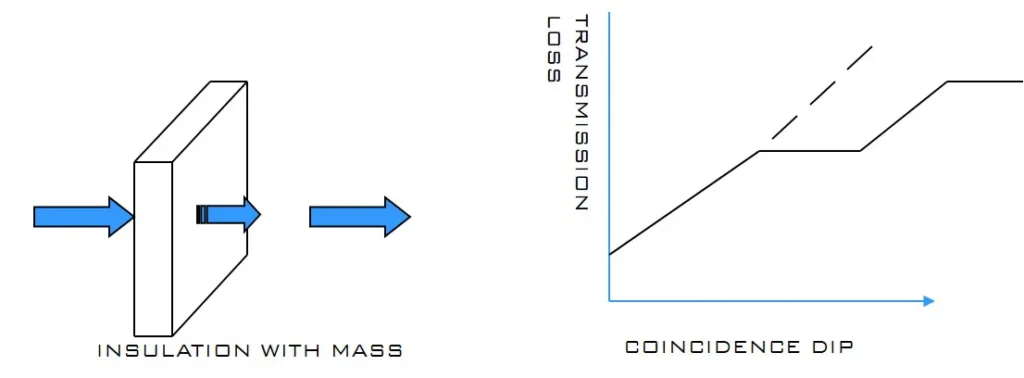
ii) Coincidence dips
- The inherent resonant frequency of a material or assembly results in a reduced insulation value at that particular frequency.
- Materials with the same mass can have varying resonant frequencies due to the different rigidity of different materials or method of attachment and assembly.
5) Environmental acoustics
i) Noise sources
- Environmental acoustics is mainly concerned with noise, or undesirable sounds- especially in urban conditions.
- Noise levels are in- creasing with greater population density. Environmental sound levels have increased constantly over time, although complaints about disturbing noise have been commonplace since antiquity.
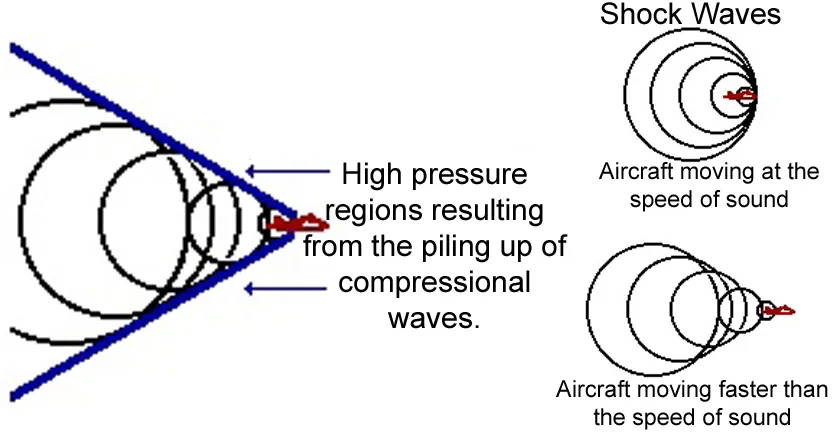
ii) Noise surveys
- Measurements of noise data can consist of short-term and long- term surveys and when combined, can present a picture of existing or expected noise levels.
- Besides basic sound level measure- ; ments in decibels, recordings can be interpreted through spectrum analyzers for frequency-specific data.
iii) Reduce the noise at the receiving location
- This is not as effective as reducing the source level, but
- Modest improvements can be achieved by adding sound absorption to the receiving room.
- Technically more a room acoustic strategy, this method can reduce the effect of transmitted sound, although at the expense of the sonic characteristics within the space.
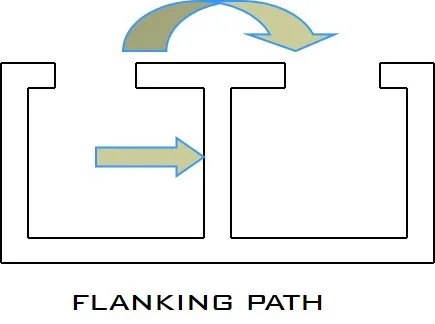
iv) Reduce the noise at the source
- The reduction of the sound energy at the source is a very effective way of reducing sound transmission. Where possible, this method can produce good results at minimum cost.
v) Block the path from the source to the critical space
- The main subject of this chapter, sound insulation through construction elements is the most common method of reducing sound transmission in buildings.
vi) Outdoor barriers
- Freestanding structures and buildings can deflect, absorb or Reflect sound, especially higher frequencies. Diffraction around barriers occurs for lower frequencies, making them less effective at greater distances.
vii) Vegetation
- Surface vegetation can help attenuate propagated sound. .However, the shielding effect of trees and shrubs is often overestimated.
- A thin visual barrier of greenery has a negligible effect as a sound barrier.

viii) Building placement
- The orientation and overall shape of buildings can block or propagate undesired noise and affect sound levels.
ix) Building features
- Barriers, balconies, overhangs, atriums, recesses and surface treatments in building designs can be used to improve acoustical protection from outdoor noise. Shadow zones out of the acoustical line of sight from nearby sources can protect openings.

- Diffraction around barriers and unwanted reflections from hard surfaces need to be considered.
- The correct detailing and construction of building elements like windows, doors and mechanical systems are further steps in blocking unwanted noise.
6) Sound absorption coefficient
i) Total room absorption
- The sum of all room surfaces multiplied by their respective
- Absorption coefficients adds up to the total room absorption.
A = total room absorption (Sabin)
S= surface area (sf)(m2)
A = sound absorption coefficient at a given frequency

- The sound absorption coefficient (a) is the indicator of a material’s absorption capacity.
- It describes the fraction of the incident sound energy a material absorbs at a given frequency.
- One square foot of perfect (100%) sound absorption equals 1 cabin. Materials with a high a (over 0.5) are considered absorptive, materials with a iowa (below 0.2) are reflective.
- Manufacturers provide values for specific building products.
7) Sound absorption
i) Diaphragmatic absorbers
- Most effective in the low frequency range at their own resonant frequency, resonating panel absorbers can be tuned to specific frequencies and wavelengths.
- While they can be inadvertently present as glazing, drywall or paneling, sometimes with adverse effects, they can be used purposely to supplement porous absorbers, balancing the overall absorption range.
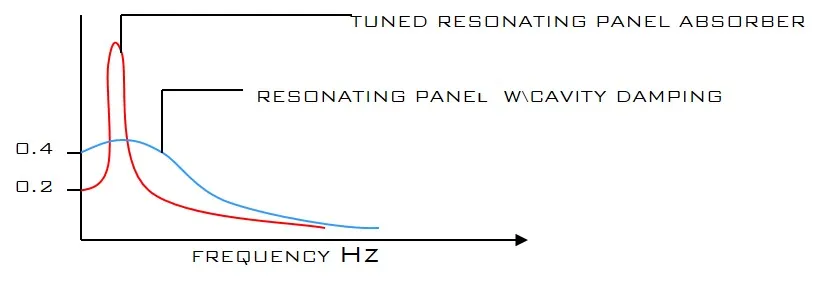
- Diaphragmatic absorbers vibrate in response to sound, thereby absorbing its energy.
- Factors affecting the frequency response are the panel density and the depth of the airspace behind.
- A broader bandwidth can be absorbed by adding porous material inside the airspace, thereby acoustically damping the cavity; or by varying the depth of the airspace.
ii) Sound absorption methods
- Three main types of sound absorbers can be differentiated. The greatest effect across the entire spectrum is achieved with a combination of different absorbers.
8) Sound transmission
i) Types of sound transmission
- Sound transmission occurs through the interaction Between sound in air and sound in solids. The two basic types of sound transmission in buildings are airborne and structure-borne sound. Although one or the other is usually predominant, a combination of both is common, and they should both be evaluated in parallel for comprehensive results.
ii) Structure-borne sound
- Sound waves transmitted through solids, such as floors, walls, ceilings. Typical examples of structure-borne sound are footfall and vibrations caused by machinery.
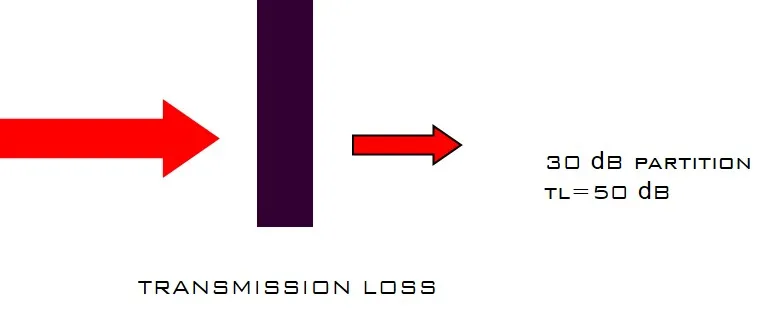
iii) Airborne sound
- Sound waves transmitted through the medium of air. The best defense against airborne sound is an airtight enclosure. Sound waves resonate a panel (e.g., A wall) – the vibrating panel re-radiates sound, acting as a new, but weaker sound source.
- The reduction of the sound energy is achieved by dissipation into the structure or reflection of the energy back to the source
9) Conclusion
- Environmental acoustics is mainly concerned with noise, or undesirable sounds- especially in urban conditions, noise levels are in- creasing with greater population density.
- The reduction of the sound energy at the source is a very effective way of reducing sound transmission. Where possible, this method can produce good results at minimum cost.
- Surface vegetation can help attenuate propagated sound. However, the shielding effect of trees and shrubs is often overestimated. A thin visual barrier of greenery has a negligible effect as a sound barrier.
- Absorption is the transformation of sound into another form of energy, for example into heat. The level of sound absorption in a space has a great effect on the reverberation time and loudness
Overall, the most effective acoustic insulation methods will depend on the specific needs and requirements of a given building or space. A professional acoustic consultant can assess the sound transmission characteristics of a building and recommend the best insulation methods to achieve the desired level of acoustic performance.